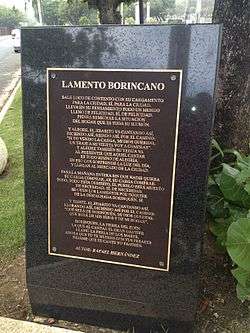Lamento Borincano
| "Lamento Borincano" | |
|---|---|
| Single by Rafael Hernández Marín | |
| Released | 1929 |
| Format | |
| Recorded | 1929 |
| Genre | bolero |
| Length | 6:37 |
| Label | Sony Discos |
| Writer(s) | Rafael Hernández Marín |
| Producer(s) | Fernandito Álvarez[1] |
"Lamento Borincano" (English: Puerto Rican Mourning) is Rafael Hernández Marín's acclaimed composition in Puerto Rico's patriotic tradition. It takes its name from the free musical form Lament (Latin, lāmentor), and from Borinquen, an indigenous name for the island. Hernández released the song in 1929 to illustrate the economic precariousness that had engulfed the Puerto Rican farmer since the late 1920s' Puerto Rico. It became an instantaneous hit in Puerto Rico and its popularity soon followed in any countries of Latin America. Renown international artists have sung it and featured it in their repertoire.[2][3]

History
Hernandez composed the song while he lived in New York City, in Spanish Harlem. That same year, he also wrote his masterpiece, "Preciosa". In 1947, Hernández returned to Puerto Rico to become an orchestra director at the government-owned WIPR Radio.[4][5] Lamento Borincano was interpreted by dozens of artists and became an important part of Puerto Rican culture.[6]
In 1929, 17-year-old Davilita met Rafael Hernández by chance. Davilita got along quite well with Hernández Marín and was able to see the unfinished version of Hernandez's "Lamento Borincano". Davilita asked Hernandez if he could record the song but, Hernandez thought that Davilita was too young and declined his request. The song was to be recorded by Ramon "Canario" Quiroz with Davilita and Fausto Delgado as back-ups. However, fate had a different plan: Quiroz became ill on the day of the recording and Davilita ended up doing the recording as the lead voice.[7]
Theme
The song reflects the economic situation of the poor farmers in the Puerto Rico during the 1920s years leading to the Great Depression. The song starts with a cheerful and optimistic tone, presenting the jibarito, (a self-subsistence farmer descendant from the taino, Spaniards and/or African people, who is the iconic reflection of the Puerto Rican people of the day. The jibarito was a farmer-salesman who heads to town to sell his load of fruits and vegetables. Disappointed to see the poverty that in town and unable to seel his load, the jibarito returns home with his load unsold. The song does not name Puerto Rico by its modern name, instead using its former pre-Columbian name "Borinquen".[8]
Chorus
The chorus reads,
Borinquen! La tierra del Edén
la que al cantar, el gran Gautier
llamo la perla de los mares
ahora que tú te mueres con tus pesares
déjame que te cante yo también
(English: Borinquen! The land of the Eden/The one that when sung, by the great Gautier/He called the Pearl of the Seas/Now that you lay dying from your sorrows/Let me sing to you also.)
however, though Rafael Hernández names the Puerto Rican poet José Gautier Benítez, some artists who have recorded the song replace his name with the word "Gotier" in place of Gautier.
Recordings
|
|
Following is a partial listing of recordings of the song by artists.
- Marco Antonio Muñiz. Los Grandes Exitos de Marco Antonio Muñiz (RCA International, 1983)
- Gilberto Monroig. Grandes Compositores, Rafael Hernandez: Volumen 3 (Polygram Records, 1994)
- Javier Solís. Personalidad: 20 Exitos (Sony Discos, 2002)
- Alfonso Ortiz Tirado. Original version of the song that became an immediate hit
- Paco de Lucía (duet with Ramón de Algeciras). En Hispanoamérica
- Chavela Vargas
- Franck Pourcel. Instrumental
- Banda Los Escamilla. Album: La Consentida (2004)
- Conjunto Primavera
- Caetano Veloso
- Ginamaria Hidalgo
- Chelito de Castro (with Juan Carlos Coronel)
- Plácido Domingo
- Óscar Chávez
- Pedro Infante
- Roberto Torres
- Toña la Negra
- Víctor Jara (Canto libre, 1970)
- Daniel Santos
- Estela Raval y Los 5 Latinos
- Radio Pirata Version Rock
- Marc Anthony Version Salsa
- Marc Anthony. Sigo Siendo Yo: Grandes Exitos
- Los Indios Tabajaras Instrumental
- Leo Marini
- Facundo Cabral
- Pedro Vargas
- La Lupe (with Tito Puente)
- Los Panchos
- José Feliciano (with Luis Fonsi)
- Enrique Cardenas Instrumental
- Marc Anthony, Ednita Nazario, Gilberto Santa Rosa and Ruth Fernández in the Banco Popular de Puerto Rico special, "Romance del Cumbanchero".
- Edith Márquez
- Ainhoa Arteta
- Cuco Sánchez
- William Cepeda Version Bomba
- Las Acevedo, a Tribute to Chavela Vargas La Chamana.
- Trio Los Andinos with Carmin Vega in "Los Andinos: Homenaje a Rafael Hernandez, con Carmin Vega". (2003, Disco Hit Productions)
References
- ↑ Cumple 60 ‘En mi Viejo San Juan’. Miguel López Ortiz. Fundación Nacional para la Cultura Popular. 25 August 2006.
- ↑ Rodriguez, Arnaldo (May 9, 2000). "En Nueva York 'El Cofresi' de Rafael Hernandez". Impacto.
- ↑ Galán, Tacho (2014). "Lamento Borincano". In Stavan, Lian. Latin Music : Musicians. Genres, and Themes. 1–2. Westport. CT. USA: Greenwood, 2014. p. 390.
- ↑ Hernandez Marin, Rafael
- ↑ Rafael Hernández Marín. Encyclopedia Puerto Rico. 6 February 2014.
- ↑ History of Puerto Rico.
- ↑ music of Puerto Rico
- ↑ Preciosa: The People, History, and Music of Puerto Rico. Mark U. Reimer. Christopher Newport University. Proceedings of the May 2010 Conference of the Global Awareness Society International in San Juan, Puerto Rico. Page 11. May 2010. Retrieved 7 February 2014.